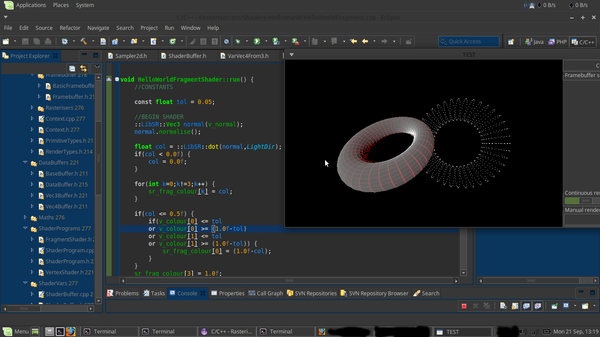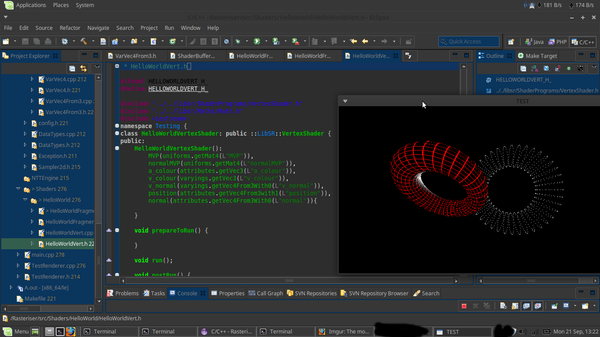Difference between revisions of "LibSR:Proof of concept"
From Maths
(Created page with "There's an old proof-of-concept implementation written in C++, it supports depth tests, vertex and fragment shaders, and there's limited work on texture objects, oh and render...") |
m |
||
| Line 1: | Line 1: | ||
| + | ==Overview== | ||
| + | This was a rushed proof of concept, nothing more. The critical things that needed to be proved were: | ||
| + | # A natural handling of shader variables, code must read {{C|z=x*y}} not {{C|varyings.assign("z",MAT4F::Multiply(varyings.get("y"),varyings.get("z"));}} or something, and statically typed. | ||
| + | #* ''Both'' of these were achieved. | ||
| + | #* However there was a problem, due to the {{ckw|virtual}} methods in play (among other things) it was slow, also it could not be easily made parallel, a re-write would be easier. | ||
| + | # How a rasteriser might work (see: [[LibSR:Rasteriser]]), its performance and so forth (the [[LibSR:Proof of concept rasteriser]] was very poor indeed). | ||
| + | |||
| + | |||
| + | |||
| + | =Stuff to go on page= | ||
There's an old proof-of-concept implementation written in C++, it supports depth tests, vertex and fragment shaders, and there's limited work on texture objects, oh and renderbuffers, so it is double-buffered. | There's an old proof-of-concept implementation written in C++, it supports depth tests, vertex and fragment shaders, and there's limited work on texture objects, oh and renderbuffers, so it is double-buffered. | ||
I often show the following screenshots: | I often show the following screenshots: | ||
Revision as of 04:27, 15 June 2016
Overview
This was a rushed proof of concept, nothing more. The critical things that needed to be proved were:
- A natural handling of shader variables, code must read not varyings.assign("z",MAT4F::Multiply(varyings.get("y"),varyings.get("z")); or something, and statically typed.
- Both of these were achieved.
- However there was a problem, due to the virtual methods in play (among other things) it was slow, also it could not be easily made parallel, a re-write would be easier.
- How a rasteriser might work (see: LibSR:Rasteriser), its performance and so forth (the LibSR:Proof of concept rasteriser was very poor indeed).
Stuff to go on page
There's an old proof-of-concept implementation written in C++, it supports depth tests, vertex and fragment shaders, and there's limited work on texture objects, oh and renderbuffers, so it is double-buffered. I often show the following screenshots:

|
| Example showing a Fragment shader which renders a red border around quad
patches where the light is below a certain intensity. |
|---|

|
| The corresponding Vertex shader showing how Uniform variables and
Varying variables are bound to shaders. |
|---|